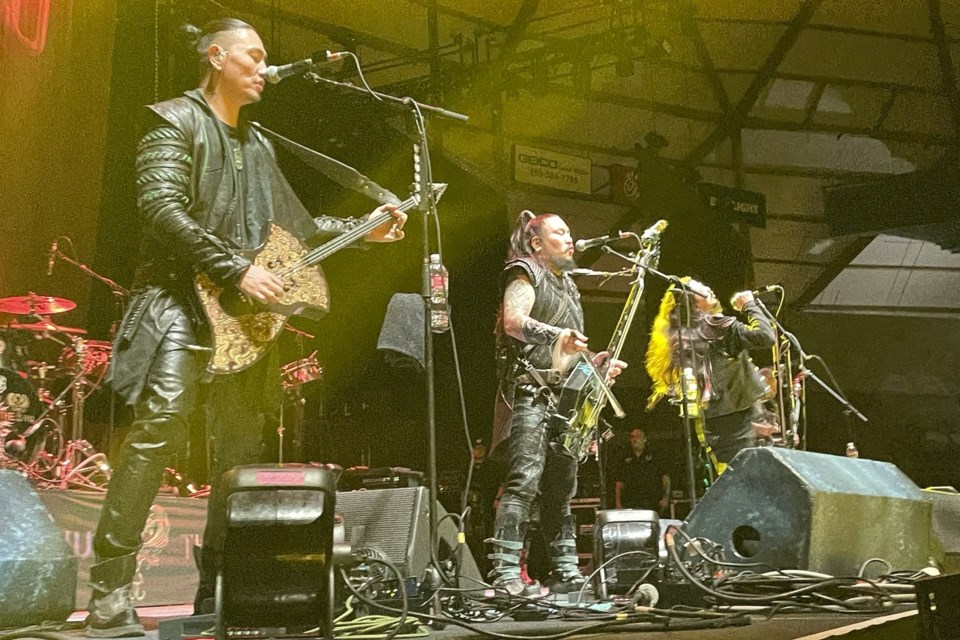(RNS) ŌĆö An eight-man heavy metal band from Mongolia known as has done what few thought could happen in the 21st century: Create a new genre of folk-metal music. Decked out in black war regalia out of the 13th century, they sing invocations to a Mongolian sky deity and odes to 13th century warlord Genghis Khan.
Not that anyone seems to really notice. At a recent performance opening for heavy metal superstars Iron Maiden at the Tacoma Dome in Washington state, the bandŌĆÖs lead singers, winging their long black hair to the raucous beat, belt out their lyrics in a deep guttural drone-like style known as throat singing. In Mongolian.
Their success ŌĆö The Hu is the first Mongolian band to top a Billboard chart (in 2019 and theyŌĆÖve been streamed 780 million times on Spotify ŌĆö arguably has little to do with their message, which includes thoughts on war, destiny and climate change. It has everything to do with their style, beginning with their impressive entrance under a black Mongolian war banner and their wild-horse-steppe Mongolian vibe.
___
This content is written and produced by Religion News Service and distributed by The Associated Press. RNS and AP partner on some religion news content. RNS is solely responsible for this story.
___
But underlying their Hun metal demonstrativeness is a shamanist spirituality and their devotion to the chief embodiment of sky deity Tengri, a folk pantheism they share with some 5% of Mongolians.
About 50% of the populace is Tibetan Buddhist, 40% are atheist (thanks no doubt to 70 years of Communism under the Soviets), with the remaining 10% evangelical Christians, Tengrists/shamans, Muslims, Mormons and a sliver of Catholics.
In the Mongolian tradition, shamans use rituals and trance states to communicate with the dead or spiritual beings. Although the players donŌĆÖt claim to be shamans, the pounding ŌĆ£Shoog, Shoog,ŌĆØ one of their early songs, is the shamanic call to ancestral spirits.
Front man Temuulen ŌĆ£TemkaŌĆØ Naranbaatar, 34, who plays an electric ŌĆ£tovshuur,ŌĆØ a gold-embossed three-stringed lute, said he was on a spiritual search about the time he joined up with the band in 2016. ŌĆ£I was not much of a believer if you will,ŌĆØ he said through a translator in a pre-show interview in Tacoma. ŌĆ£I was curious what the Christian church had to offer and just visited with my friends a couple of times. But it was nothing more than that.ŌĆØ
His musical journey, however, brought Temka in contact with songwriter and producer Bayarmagnai Dashdondog, a veteran in the Mongolian pop music industry. Temka, then 26, and the other young men who would form The Hu, clicked with the nature religion described in DashdondogŌĆÖs lyrics.
ŌĆ£The traditions of Tengerism are very interconnected to our culture, to our nomadic life,ŌĆØ Temka said. ŌĆ£The nomadic way of life also affects how your brain works ŌĆ” that is how my brain works; that is why I am who I am today.ŌĆØ
Dashdondog, the mastermind behind the groupŌĆÖs rise, is in his 50s. Band members have described him as a man who has traveled back to his roots in MongoliaŌĆÖs western Khovd province to write songs for his father and ancestors. His compositions for The Hu are aided by ŌĆ£my parents and my ancestors,ŌĆØ in 2022.
Songs such as ŌĆ£This is the MongolŌĆØ and ŌĆ£Upright Destined MongolŌĆØ laud the ŌĆ£glory of our ancestorsŌĆØ and describe ŌĆ£ancestors who thrived worshipping the sacred mountain Khaldun,ŌĆØ believed to be Genghis KhanŌĆÖs birthplace.
ŌĆ£For us, Tengerism is a belief system that our ancestors are looking over us, but it does not necessarily mean we have a certain Bible or any other religion or a Quran,ŌĆØ said Temka. ŌĆ£ItŌĆÖs a belief that ŌĆ” we are guided through our ancestor spirits.ŌĆØ
In mid-2018, Dashdondog sent his proteges on a 3,100-mile trek through western Mongolia, where they taped Yuve, Yuve, Yu, a stunning video filled with dramatic landscapes.
It was a smash hit. The world couldnŌĆÖt get enough of what looked like four Huns in black leather or brown tunics, or ŌĆ£deels,ŌĆØ interwoven with metal studs, buckles, chains, bones and feathers. A drone captures them striding about in upturned traditional ŌĆ£gutalŌĆØ boots, hair braids flying, and hoisting all manner of exotic stringed instruments while singing about prophecy and the second coming of Genghis Khan.
That was followed by The Wolf Totem, a bestselling video showcasing a man on a horse carrying a black Mongolian war banner, followed by a posse of stern leather-clad men on motorcycles doing war chants. YouTube views soared into the millions.
DashdondogŌĆÖs influence clearly looms large, but the actual religious composition of the band is somewhat vague. When The Hu formed in 2016, two of the four additional members, Temka said, had Christian backgrounds. Guitarist Jambaldorj ŌĆ£JambaŌĆØ Ayush, he said, used to attend a Christian school; Odbayar ŌĆ£OdkoŌĆØ Gantumur was a drummer for a church. Enkhsaikhan ŌĆ£EnkushŌĆØ Batjargal, a front band member who plays a box-shaped horse fiddle known as the ŌĆ£morin khuur,ŌĆØ grew up Buddhist, Temka added.
A dive into OdkoŌĆÖs Facebook page revealed Christian-friendly posts in 2012, such as music from the Australian band Hillsong and a post that reads ŌĆ£With God, all things are possible.ŌĆØ
Temka swears it all works when it comes to making music. ŌĆ£We have a very high tolerance in terms of religious differences,ŌĆØ he said. ŌĆ£All of us match our energy together.ŌĆØ
When asked what this looks like in the day-to-day life of the band, Temka said the group gathers about 10 minutes before their show to call down energy and shout out the word ŌĆ£hu,ŌĆØ which ŌĆ£helps us be in sync on stage all together.ŌĆØ
ŌĆ£We do call on our ancestors in that chant together,ŌĆØ he said. ŌĆ£There are eight people. We try to match our energies and try to bring them on stage. That helps us give the energy to our audience and helps them understand the meaning of the words without having to translate the words.ŌĆØ
Julia Duin, The Associated Press


